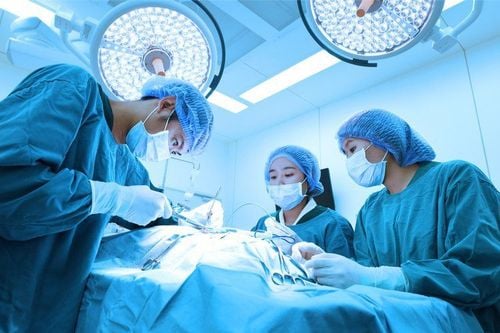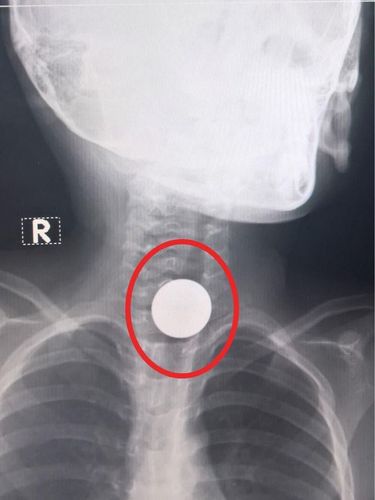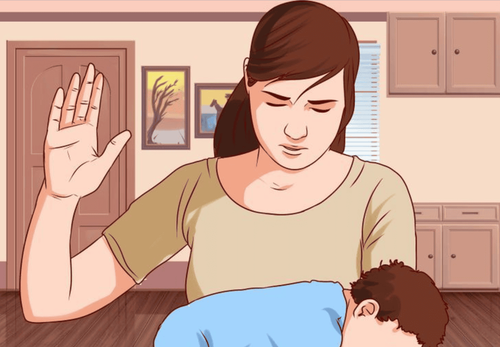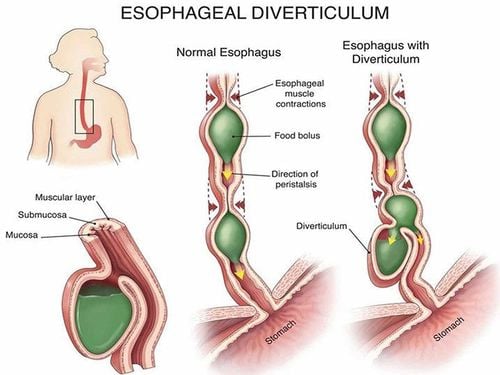This is an automatically translated article.
Open neck surgery is surgery to open into the connective tissue around the cervical esophagus, right next to the carotid bundle to drain pus or remove foreign objects in the airway, or open into the esophagus, next to the esophagus to remove food. esophagus or suture.1. Indications for open neck surgery
Open neck surgery is indicated when:Periesophageal abscess due to esophageal foreign body punctures the esophagus out, opening to drain the abscess's pus. Inflammation of the connective tissue in the neck. Traumatic perforation of the esophagus. The esophageal foreign body is too large and cannot be removed by natural sugar. Open the edge of the neck to remove the esophageal diverticulum.
2. Preparing for neck opening surgery
Patient preparation:The patient is carefully prepared and prepared for the patient's family in advance for possible surgical complications, post-operative eating and drinking problems. Careful resuscitation before surgery because patients often cannot eat or drink for a long time. In case the patient has difficulty breathing, there are 2 ways to deal with it before surgery: Aspiration of pus or substances causing compression (if aspiration is possible). If aspiration is not possible, tracheostomy can be performed prior to paracervical opening. The person performing the open neck surgery:
Level I ear, nose and throat specialist and the assistant. The surgeon stands on the side to be operated on. The first assistant stood opposite the surgeon. The second assistant stands at the head of the patient. Prepare surgical equipment: 02 Scalpels; 01 dissection of the trough; 01 straight scissors; 01 long curved stretch; 01 surgical pliers with and without teeth; 04 Kocher pliers; 10 Halsted pliers; 02 Farabeuf balls; pliers and sewing needles; 04 surgical pliers, 01 Kocher pliers 20cm; towel, gauze, thread (linen and catgut), Nelaton pine; suction tube and suction line.
3. Carrying out open neck surgery

Bệnh nhân sẽ được gây mê hoặc gây tê tùy từng trường hợp
Surgeon: stand on the operating side, assistant 1 stands opposite the surgeon, assistant 2 stands at the head of the patient.
Anesthesia or anesthesia depending on the case
Pre-anesthesia and general anesthesia . Pre-anesthesia, local anesthesia. A 10mm rubber tube should be placed through the nose into the esophagus for easy identification during surgery. Stage 1: Skin incision
Skin incision 10cm long along the anterior border of the sternocleidomastoid muscle starting from the superior border of the thyroid cartilage to the sternoclavicular joint, or 1-2cm above the sternoclavicular joint. Incision through the skin and skin attachment muscles, the superficial jugular veins are cut and tied. Find the superficial cervical fascia, make an incision in the superficial cervical fascia in front of the sternocleidomastoid muscle. Use the trough river to continue to release the anterior border of the sternocleidomastoid muscle, release the superficial cervical fascia, and use the Farabob ball to pull the sternocleidomastoid muscle out. Stage 2: Cut the middle cervical fascia
First find the muscles under the nail: sternum hyoid, sternum thyroid, shoulder girdle. Use the trough to dissect these muscles, resecting along with the median cervical fascia from top to bottom. In case there is a pocket of pus on the side of the esophagus, the muscles of the sternum nail, the thyroid gland swell, when we make an incision through the middle neck fascia, the pus will flow out, sucking the pus. When reaching the deep cervical fascia, we can see the carotid artery pulsating outside, using the trough to dissect the entire carotid bundle, then using Farabob to pull this bundle out. Stage 3: Cut and tie the thyroid blood vessels.
Pulling the thyroid gland inward, pulling the carotid and sternoclavicular muscle out, between the thyroid and the carotid bundle, there are the following blood vessels:
The middle thyroid vein passes from the thyroid gland to the vena cava Upper: Tie and cut. The inferior thyroid artery is at C5-C6 level, so ligation of this artery is distal to the thyroid gland because this artery feeds both the thyroid and parathyroid glands and because there is a recurrent cord that crosses the artery adjacent to the thyroid gland. At this time, we can pull the thyroid gland up, inward and anteriorly, then we will see the cervical vertebrae located just behind the esophagus and trachea (the esophagus has longitudinal fibers from above). In the anterior aspect of the esophagus, the recurrent nerve must be found to protect it (on the left side, the recurrent nerve runs further away from the esophagus). Stage 4: Esophageal incision
Only make an esophageal foreign body incision when the foreign body is too large to be taken through the mouth. An esophageal incision should be made distal to the recurrent nerve, i.e. an incision posteriorly to the esophagus. Using a knife to cut the serosa and muscle, when reaching the mucosa, use 2 rat-tooth pliers to lift up at both ends, cut the mucosa along the muscle incision, then use curved Kocher pliers to insert into the oesophagus to remove foreign bodies. In case the foreign body is deep, the finger should be completely inserted into the lumen of the esophagus to find the foreign body. Then 5: Treat the incision.
Depending on the condition of the incision and the esophagus, decide whether to suture the esophagus or not. If the esophagus is slightly damaged, we suture the esophagus into 2 layers, the mucosal layer with liniment, the muscle layer with a catgut, and then place and place drainage drains, suture the sternocleidomastoid muscle and the subungual muscle, then leave the skin open or suture thin skin. Usually the esophageal abscess ruptures on the 6-7th day, if the esophagus is damaged and necrotic, surrounded by pus, do not suture the esophagus and leave the entire surgical hole open, then use antibiotics to fill the incision. . Insert the esophageal tube through the nose to nourish the patient after surgery.
4. Monitoring and handling of accidents
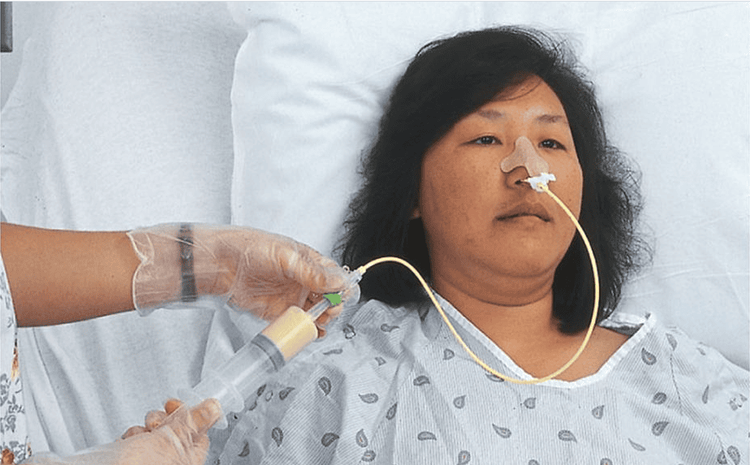
Bệnh nhân có thể phải ăn qua sonde đến 1-2 tháng cho đến khi hố mổ liền lại
During the first 24 hours of nutrition infusion. The following days feed completely through the tube. It may take 1-2 months to eat through the tube to wait for the incision to heal. Change the dressing several times/day in case of pus-filled incision. Management of possible complications:
Purulent mediastinitis due to pus overflowing from the neck area: antibiotics, mediastinal drainage, continuous aspiration. Purulent pleurisy: puncture drainage of pleural effusion. Carotid artery rupture due to perforation by a foreign body in the esophagus or by an infection that ruptures the blood vessel; Massive bleeding: The surgeon presses firmly with his finger on the torn part of the vessel. If not treated quickly, the patient will die, clamp with clamps on both ends of the hole, clean the wound and sew up the blood vessel. Open neck surgery to remove airway foreign body and esophageal foreign body is a relatively complicated surgery. Requires the operator to have high expertise and modern surgical medical equipment to help promptly handle possible complications.
Vinmec International General Hospital is a high-quality medical facility in Vietnam with a team of highly qualified medical professionals, well-trained, domestic and foreign, and experienced.
A system of modern and advanced medical equipment, possessing many of the best machines in the world, helping to detect many difficult and dangerous diseases in a short time, supporting the diagnosis and treatment of doctors the most effective. The hospital space is designed according to 5-star hotel standards, giving patients comfort, friendliness and peace of mind.
Please dial HOTLINE for more information or register for an appointment HERE. Download MyVinmec app to make appointments faster and to manage your bookings easily.




